+91-9240214610 (Bandra)
+91-9240214611 (Kandivali)



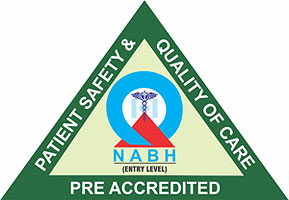
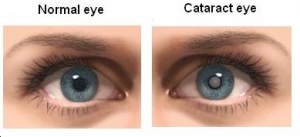
The opacification of the normal transparent lens is called cataract. The Latin word ‘cataracta’ means ‘waterfall’. Imagine trying to peer through a sheet of falling water or through a frosted or fogged-up window. Development of Cataract varies from person to person but as a general rule, most cataracts develop slowly over a period of time. A cataract can take months or even years to reach a point where it adversely affects vision.
The cataract occurs as a result of the natural aging process of lens fibres which become opaque over a period of time.
This occurs as a result of excess intake of oral steroid or putting steroid drops in the eye.
Here, cataract develops as a result of some other primary ocular disease such as chronic eye inflammation or glaucoma.
The earliest surgery treatment was started in India, by Maharshi Sushruta. It was known as ‘couching’, where the cataractous lens was dislocated backward into the bottom of the eye and out of visual axis.
This procedure was performed for more than two thousand years until the mid-eighteenth century. Great progress in cataract surgery has been made in recent years with the introduction of micro-surgical instruments, microscope and modern surgical techniques like phacoemulsification, which has made couching obsolete.
In the early stages of cataract development, all that is needed to correct your vision with glasses is a change in prescription. As the cataract develops and begins to affect your lifestyle, it needs to be removed. Cataract surgery, the most commonly performed operation, is safe and effective in 95% patients with enhancement in vision.
Visual acuity: Checking vision of both eyes unaided and aided with glasses and pin-hole vision to know the improvement as well as to get the general idea about the macular function of the eyes. This will help in prognostic evaluation of visual recovery after cataract surgery.
Intra ocular pressure: If intra-ocular pressure increases as a secondary to cataract surgery is needed to prevent further complications.
Slit-lamp examination: To know the type of cataract along with its opacity, morphology and etiology or any associated ocular pathology.
Direct and indirect ophthalmoscopy: for complete retinal evaluation. Dense cataract will prevent retinal evaluation and such cases need B-scan for retinal evaluation.
A-scan biometry: To calculate the AL and IOL power for implantation in cases of mature cataract the posterior segment of the eye is evaluated.
Optical biometry: this is an advanced non contact method to measure IOL power. It is patient friendly and highly precise
Cataract Surgery Explain By Dr Niteen Dedhia
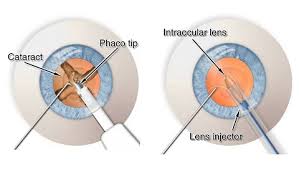
Phacoemulsification is latest technology in Cataract surgery. It is a micro-incisional stitch less operation where cataract is emulsified by ultra sound energy, liquefied & sucked through the phacoemulsifier probe. A foldable intra- ocular lens is then implanted in the eye permanently.
Vision restoration is possible in a short period of time & is least traumatic with early rehabilitation & recuperation.
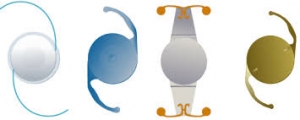
During cataract surgery, the natural lens of the eye that has turned opaque is removed, resulting in loss of focusing power of the eye. This situation would be parallel to clicking a photograph without a camera lens–the picture would be extremely blurred. When the natural lens of the eye is removed an artificial implant is placed in the eye.
An intraocular lens (IOL) implant is a synthetic, artificial lens placed inside the eye that replaces the natural lens which is surgically removed usually as a part of cataract surgery.
Monofocal intraocular lens can be used to give clear point focus either at a distance or close up, but one can choose only one focal point.
Multifocal IOLs are popular as they allow correction of vision for both far & near distance.
EDOF Lens The Extended Depth of Field (EDOF) IOL provides spectacle independence as well as correction for near, distant, and intermediate vision. For example, if you get these lenses postcataract surgery, you will be able to drive and paint well. Both these activities require clear intermediate vision. As a result of your clear near vision, you can also read a book or a newspaper. As a result of your clear near vision, you can also read a book or a newspaper.
Trifocal IOLs provides excellent vision not only for near and far, but also for intermediate distances, especially for people who have routine usage of computers.
Gradual diffractive steps on the IOL implant that create a smooth transition between focal points. The IOL bends incoming light to the multiple focal points to increase vision in differing light situations.
Crystalens and Trulign Toric currently are the only US-FDA -approved intraocular lenses (IOLs) that use a method called accommodation, enabling sharper vision at multiple distances for people who have undergone cataract surgery.
An accommodating IOL shifts position with the action of eye muscles and movement to improve eyesight.
This is a monofocal IOL with astigmatism correction built into the lens.
IOLs include filters to protect the eye’s retina from exposure to UV and other potentially damaging light radiation. The eye doctor selects the filters that will provide appropriate protection for the patient’s specific needs.
Other important cataract lens replacement considerations
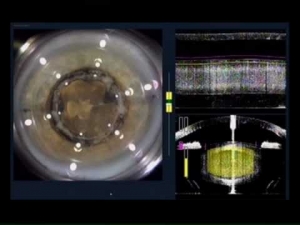
Laser-assisted cataract surgery is now available to our cataract patients.
The Femtosecond Laser applies laser energy in an extremely short period of time, one trillionth of a second, so no significant heat is generated (therefore, it is a “cool” laser). The laser, guided by an advanced imaging system known as OCT, creates precise incisions, automating steps of cataract surgery that have traditionally been done manually with a surgical blade. The laser can also make corneal incisions to treat astigmatism. The computer-driven incisions are more precise and reproducible than what can be done manually by hand.
In laser cataract surgery, an advanced Femtosecond Laser replaces or assists use of a hand-held surgical tool for the following steps in cataract surgery:
Use of a laser can improve the precision, accuracy and reproducibility of each of these steps, potentially reducing risks and improving visual outcomes of cataract surgery.
In laser cataract surgery, the surgeon creates a precise surgical plan for the corneal incision with a sophisticated 3-D image of the eye called an OCT (optical coherence tomography).
An incision with a specific location, depth and length in all planes with the OCT image and a femtosecond laser can be performed exactly without the variable of surgeon experience.
Understanding Cataract with Dr. Niteen Dedhia | Cataract specialist in Mumbai
If you are looking for Cataract Surgery In Mumbai, Bladeless Lasik in Mumbai or Best Cataract Treatment in Mumbai, Ojas Eye Hospital is here to assist. Ojas Eye Hospital can help with your Cataract surgery procedure, including: Cataract Removal, Cataract Eye Treatments, Refractive Cataract, etc. Ojas Eye Hospital has served many Cataract clients in Mumbai City.
Contact Ojas Eye Hospital today for all your Cataract needs in Mumbai City at Call us (+91) 9137462795.
With the growing age and multiple times facing the problems of blurred vision, the need of doing an eye check up did arouse. I visited Ojas Eye hospital for the tests and soon I was diagnosed with the eye disease called Cataract. My mind was baffled with questions. Friendly approach of Dr.Dedhia, in Pre and post operations, was truly supporting. The advanced eye correction equipment did ensure the rest. My cataract operation is successful and at present I am blessed with clear vision.

DEAR DOCTOR DEDHIA & ALL AT LASER EYE CENTER ;
It is been a wonderful experience to know you all and also to be treated by such a friendly and excellent team of professionals. What you all have done for me is just inexplicable all can say is "Thank you so much" for doing this wonder on my eyes. It really feels great to have an aid less vision. May God bless all of you all health and happiness and wish you all the very best for your work!
Dr. Nitin Dedhia is my family's eye specialist since long time. My grandmoms cataract surgery was done by him around 20 years ago. She is still having very good eyesight at 90. I too have have done my lasic around a week ago and now able to see everything without specs. Would like to advice Dr Dedhia Sir for any of your complaints regarding eyes. The all staff are well trained and cooperative. Good infrastructure too. would thank everyone there.
It was a good experience with Dr. Dedia. He is very particular about cleanliness which I liked. The staff too were quick and courteous.I am also impressed with Dr. Hardik who has explained to me in detail. And Greta too is a very efficient receptionist. Thank you all the staff for not keeping me waiting.